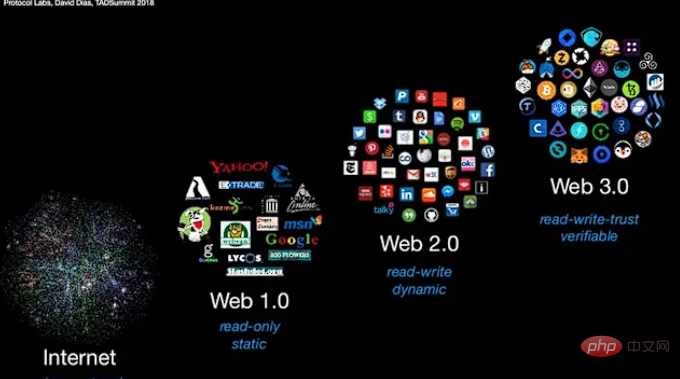What does WEB3 mean?
Web3.0 refers to the third generation of the Internet, the protocol Internet. The core is: user creation, user ownership, user control, protocol distribution of benefits, and the use of blockchain protocol creation and automatic execution technology, that is, through Smart contracts, rights and value distribution agreements can be executed efficiently, accurately, and reliably without going through a third party, and the entire process can be audited.

Brief description and understanding of Web3.0
Before we begin, let us first give you a summary of the differences between Web 1.0, Web 2.0, and Web 3.0 conclusion.
-
Web 1.0, the first generation of Internet, static Internet;
The core of Web 1.0 is: platform creation, platform ownership, platform control, and platform benefit.
-
Web 2.0, the second generation of the Internet, the interactive Internet;
The core of Web 2.0 is: user creation, platform ownership, platform control, and platform benefit.
-
Web 3.0, the third generation Internet, protocol Internet;
The core of Web 3.0 is: user creation, user ownership, user control, and protocol distribution of benefits.

Web 3.0
Represents: Blockchain, Metaverse, DAO, NFT, Chain Games Thinking content: User creation, User-owned, user-controlled, and protocol-distributed benefits.
After understanding Web1.0 and Web2.0, it will be clearer to look at Web3.0. In Web 3.0, the digital content created by users has clear ownership rights and clear control and management rights. It is owned by the user, and the value created is distributed according to the agreement signed between the user and others.
Web3.0 utilizes blockchain protocol creation and automatic execution technology, that is, through smart contracts, rights and value distribution agreements can be executed efficiently, accurately, and reliably without going through a third party. And the whole process is auditable. To put it in an easy-to-understand phrase, “there are no middlemen making the difference.” However, blockchain is only a means, and the purpose is to confirm and protect users’ digital asset rights and interests.
Take the recent hot metaverse as an example. Users’ digital asset rights and interests in the metaverse are determined and guaranteed by NFT. NFT will serve as an important token interest on Web3.0, which allows users to freely play in the metaverse. You can add, modify, and edit your own small space, and then rent, exhibit, and sell the small space to benefit from it.
The above is the detailed content of What does WEB3 mean?. For more information, please follow other related articles on the PHP Chinese website!

Hot AI Tools

Undresser.AI Undress
AI-powered app for creating realistic nude photos

AI Clothes Remover
Online AI tool for removing clothes from photos.

Undress AI Tool
Undress images for free

Clothoff.io
AI clothes remover

Video Face Swap
Swap faces in any video effortlessly with our completely free AI face swap tool!

Hot Article

Hot Tools

Notepad++7.3.1
Easy-to-use and free code editor

SublimeText3 Chinese version
Chinese version, very easy to use

Zend Studio 13.0.1
Powerful PHP integrated development environment

Dreamweaver CS6
Visual web development tools

SublimeText3 Mac version
God-level code editing software (SublimeText3)

Hot Topics
 1393
1393
 52
52
 1207
1207
 24
24
 How long does it take to recharge digital currency to arrive? Recommended mainstream digital currency recharge platform
Apr 21, 2025 pm 08:00 PM
How long does it take to recharge digital currency to arrive? Recommended mainstream digital currency recharge platform
Apr 21, 2025 pm 08:00 PM
The time for recharge of digital currency varies depending on the method: 1. Bank transfer usually takes 1-3 working days; 2. Recharge of credit cards or third-party payment platforms within a few minutes to a few hours; 3. The time for recharge of digital currency transfer is usually 10 minutes to 1 hour based on the blockchain confirmation time, but it may be delayed due to factors such as network congestion.
 What does cross-chain transaction mean? What are the cross-chain transactions?
Apr 21, 2025 pm 11:39 PM
What does cross-chain transaction mean? What are the cross-chain transactions?
Apr 21, 2025 pm 11:39 PM
Exchanges that support cross-chain transactions: 1. Binance, 2. Uniswap, 3. SushiSwap, 4. Curve Finance, 5. Thorchain, 6. 1inch Exchange, 7. DLN Trade, these platforms support multi-chain asset transactions through various technologies.
 What are the hybrid blockchain trading platforms?
Apr 21, 2025 pm 11:36 PM
What are the hybrid blockchain trading platforms?
Apr 21, 2025 pm 11:36 PM
Suggestions for choosing a cryptocurrency exchange: 1. For liquidity requirements, priority is Binance, Gate.io or OKX, because of its order depth and strong volatility resistance. 2. Compliance and security, Coinbase, Kraken and Gemini have strict regulatory endorsement. 3. Innovative functions, KuCoin's soft staking and Bybit's derivative design are suitable for advanced users.
 What is a quantum chain? What are the quantum chain transactions?
Apr 21, 2025 pm 11:51 PM
What is a quantum chain? What are the quantum chain transactions?
Apr 21, 2025 pm 11:51 PM
Quantum Chain (Qtum) is an open source decentralized smart contract platform and value transmission protocol. 1. Technical features: BIP-compatible POS smart contract platform, combining the advantages of Bitcoin and Ethereum, introduces off-chain factors and enhances the flexibility of consensus mechanisms. 2. Design principle: realize on-chain and off-chain data interaction through main control contracts, be compatible with different blockchain technologies, flexible consensus mechanisms, and consider industry compliance. 3. Team and Development: An international team led by Shuai Chu, 80% of the quantum coins are used in the community, and 20% rewards the team and investors. Quantum chains are traded on Binance, Gate.io, OKX, Bithumb and Matcha exchanges.
 Quantum Chain Exchange Ranking Top 10 Recommended (Updated in 2025)
Apr 21, 2025 pm 11:48 PM
Quantum Chain Exchange Ranking Top 10 Recommended (Updated in 2025)
Apr 21, 2025 pm 11:48 PM
Quantum chains can be traded on the following exchanges: 1. Binance: One of the world's largest exchanges, with large trading volume, rich currency and high security. 2. Sesame Open Door (Gate.io): a large exchange, providing a variety of digital currency transactions, with good trading depth. 3. Ouyi (OKX): operated by OK Group, with strong comprehensive strength, large transaction volume, and complete safety measures. 4. Bitget: Fast development, provides quantum chain transactions, and improves security. 5. Bithumb: operated in Japan, supports transactions of multiple mainstream virtual currencies, and is safe and reliable. 6. Matcha Exchange: a well-known exchange with a friendly interface and supports quantum chain trading. 7. Huobi: a large exchange that provides quantum chain trading,
 Recommend several apps to buy mainstream coins in 2025 latest release
Apr 21, 2025 pm 11:54 PM
Recommend several apps to buy mainstream coins in 2025 latest release
Apr 21, 2025 pm 11:54 PM
APP software that can purchase mainstream coins includes: 1. Binance, the world's leading, large transaction volume and fast speed; 2. OKX, innovative products, low fees, high security; 3. Gate.io, a variety of assets and trading options, focusing on security; 4. Huobi (HTX), low fees, good user experience; 5. Coinbase, suitable for novices, high security; 6. Kraken, safe and compliant, providing a variety of services; 7. KuCoin, low fees, suitable for professional traders; 8. Gemini, emphasizes compliance, and provides custodial services; 9. Crypto.com, providing a variety of offers and services; 10. Bitstamp, an old exchange, strong liquidity,
 The latest updates to the oldest virtual currency rankings
Apr 22, 2025 am 07:18 AM
The latest updates to the oldest virtual currency rankings
Apr 22, 2025 am 07:18 AM
The ranking of virtual currencies’ “oldest” is as follows: 1. Bitcoin (BTC), issued on January 3, 2009, is the first decentralized digital currency. 2. Litecoin (LTC), released on October 7, 2011, is known as the "lightweight version of Bitcoin". 3. Ripple (XRP), issued in 2011, is designed for cross-border payments. 4. Dogecoin (DOGE), issued on December 6, 2013, is a "meme coin" based on the Litecoin code. 5. Ethereum (ETH), released on July 30, 2015, is the first platform to support smart contracts. 6. Tether (USDT), issued in 2014, is the first stablecoin to be anchored to the US dollar 1:1. 7. ADA,
 What are the token trading platforms? How do novices choose their suitable token trading platform?
Apr 21, 2025 pm 08:15 PM
What are the token trading platforms? How do novices choose their suitable token trading platform?
Apr 21, 2025 pm 08:15 PM
When newbies choose token trading platforms, they should pay attention to five key indicators: 1. Security, and give priority to cold storage and multi-certification platforms; 2. Fee transparency, comparing various fees; 3. User experience and educational resources, and choosing a platform with a simple interface and providing tutorials; 4. Compliance and localization support, pay attention to regulatory licenses and fiat currency channels; 5. Liquidity and currency coverage, and choose a platform based on trading needs.



